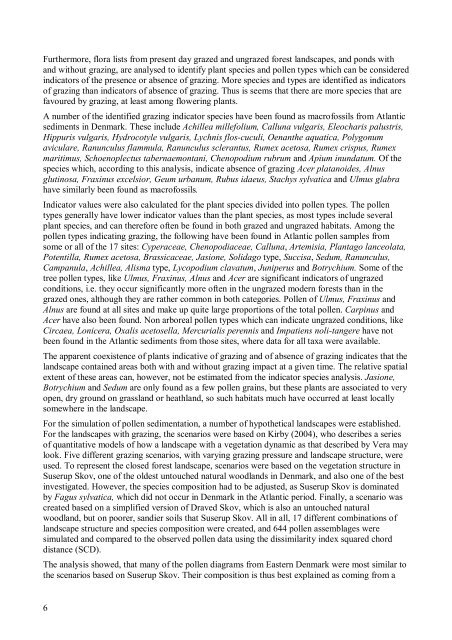Danmarks og Grønlands Geologiske Undersøgelse Rapport ... - Geus
Danmarks og Grønlands Geologiske Undersøgelse Rapport ... - Geus
Danmarks og Grønlands Geologiske Undersøgelse Rapport ... - Geus
You also want an ePaper? Increase the reach of your titles
YUMPU automatically turns print PDFs into web optimized ePapers that Google loves.
Furthermore, flora lists from present day grazed and ungrazed forest landscapes, and ponds with<br />
and without grazing, are analysed to identify plant species and pollen types which can be considered<br />
indicators of the presence or absence of grazing. More species and types are identified as indicators<br />
of grazing than indicators of absence of grazing. Thus is seems that there are more species that are<br />
favoured by grazing, at least among flowering plants.<br />
A number of the identified grazing indicator species have been found as macrofossils from Atlantic<br />
sediments in Denmark. These include Achillea millefolium, Calluna vulgaris, Eleocharis palustris,<br />
Hippuris vulgaris, Hydrocotyle vulgaris, Lychnis flos-cuculi, Oenanthe aquatica, Polygonum<br />
aviculare, Ranunculus flammula, Ranunculus sclerantus, Rumex acetosa, Rumex crispus, Rumex<br />
maritimus, Schoenoplectus tabernaemontani, Chenopodium rubrum and Apium inundatum. Of the<br />
species which, according to this analysis, indicate absence of grazing Acer platanoides, Alnus<br />
glutinosa, Fraxinus excelsior, Geum urbanum, Rubus idaeus, Stachys sylvatica and Ulmus glabra<br />
have similarly been found as macrofossils.<br />
Indicator values were also calculated for the plant species divided into pollen types. The pollen<br />
types generally have lower indicator values than the plant species, as most types include several<br />
plant species, and can therefore often be found in both grazed and ungrazed habitats. Among the<br />
pollen types indicating grazing, the following have been found in Atlantic pollen samples from<br />
some or all of the 17 sites: Cyperaceae, Chenopodiaceae, Calluna, Artemisia, Plantago lanceolata,<br />
Potentilla, Rumex acetosa, Brassicaceae, Jasione, Solidago type, Succisa, Sedum, Ranunculus,<br />
Campanula, Achillea, Alisma type, Lycopodium clavatum, Juniperus and Botrychium. Some of the<br />
tree pollen types, like Ulmus, Fraxinus, Alnus and Acer are significant indicators of ungrazed<br />
conditions, i.e. they occur significantly more often in the ungrazed modern forests than in the<br />
grazed ones, although they are rather common in both categories. Pollen of Ulmus, Fraxinus and<br />
Alnus are found at all sites and make up quite large proportions of the total pollen. Carpinus and<br />
Acer have also been found. Non arboreal pollen types which can indicate ungrazed conditions, like<br />
Circaea, Lonicera, Oxalis acetosella, Mercurialis perennis and Impatiens noli-tangere have not<br />
been found in the Atlantic sediments from those sites, where data for all taxa were available.<br />
The apparent coexistence of plants indicative of grazing and of absence of grazing indicates that the<br />
landscape contained areas both with and without grazing impact at a given time. The relative spatial<br />
extent of these areas can, however, not be estimated from the indicator species analysis. Jasione,<br />
Botrychium and Sedum are only found as a few pollen grains, but these plants are associated to very<br />
open, dry ground on grassland or heathland, so such habitats much have occurred at least locally<br />
somewhere in the landscape.<br />
For the simulation of pollen sedimentation, a number of hypothetical landscapes were established.<br />
For the landscapes with grazing, the scenarios were based on Kirby (2004), who describes a series<br />
of quantitative models of how a landscape with a vegetation dynamic as that described by Vera may<br />
look. Five different grazing scenarios, with varying grazing pressure and landscape structure, were<br />
used. To represent the closed forest landscape, scenarios were based on the vegetation structure in<br />
Suserup Skov, one of the oldest untouched natural woodlands in Denmark, and also one of the best<br />
investigated. However, the species composition had to be adjusted, as Suserup Skov is dominated<br />
by Fagus sylvatica, which did not occur in Denmark in the Atlantic period. Finally, a scenario was<br />
created based on a simplified version of Draved Skov, which is also an untouched natural<br />
woodland, but on poorer, sandier soils that Suserup Skov. All in all, 17 different combinations of<br />
landscape structure and species composition were created, and 644 pollen assemblages were<br />
simulated and compared to the observed pollen data using the dissimilarity index squared chord<br />
distance (SCD).<br />
The analysis showed, that many of the pollen diagrams from Eastern Denmark were most similar to<br />
the scenarios based on Suserup Skov. Their composition is thus best explained as coming from a<br />
6

















